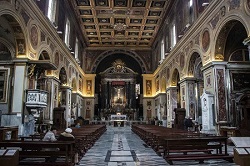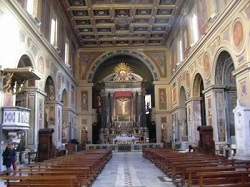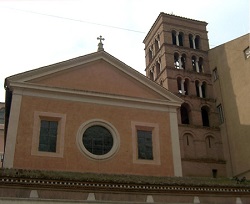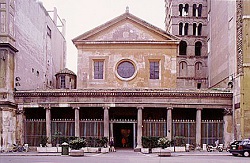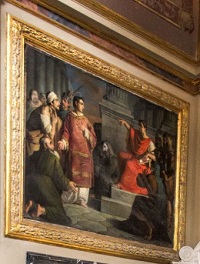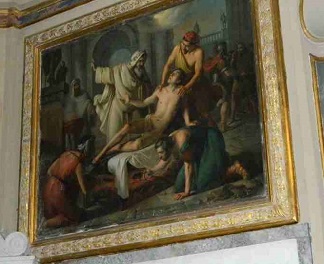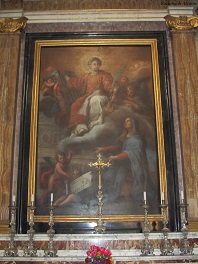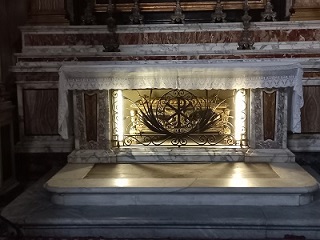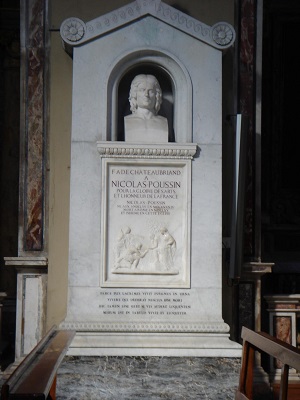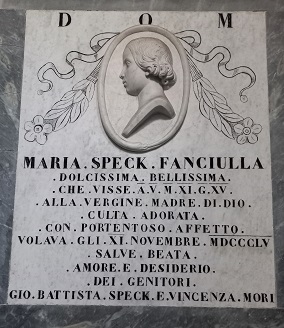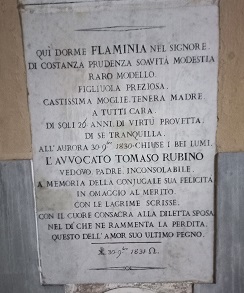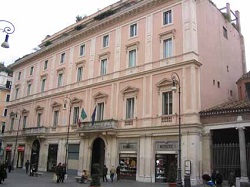The basilica of San Lorenzo in Lucina and the Lovatti Chapel in Rome
Historical and artistic notes, with an updated list of illustrious people buried in the basilica
The basilica
stands on the site of the martyrdom of the saint who died during Valerian's
persecutions in 258 AD. The area was once occupied by the northern Campus
Martius, a flat alluvial plain between the Tiber and the Pincian
Hill, where Emperor Augustus erected his Mausoleum in 29 BC
and the Ara Pacis Augustae in 9 BC, as a tribute to his dynastic glory
and the peace he had achieved. Hadrian, emperor between 119 and 138 AD,
also commissioned works here. A veritable neighborhood arose here, with an insula,
the remains of which can be seen today by visiting the underground section of
the current Basilica. This area is only open to visitors on the last Saturday of
the month. The basilica, built at the behest of Sixtus III [432-40], was
restored during the pontificate of Paschal II in 1281-87 and later in 1606, when
the church was entrusted to the Chierici Regolari Minori (Minor Clerics
Regular).
The 17th-century restoration was carried out by Cosimo Fanzago, while in
1858 the architect Busiri Vici added two chapels to the interior and
eliminated the Baroque decorations. The basilica's basement preserves
architectural remains dating back to the 2nd century. The gabled façade
features a triangular tympanum and a large central oculus, preceded by an
architraved portico. To the side stands the five-story Romanesque bell tower.
The interior is divided into three naves, but appears to be a single nave
because the side aisles are entirely occupied by chapels (four on the right and
four on the left, as well as the baptistery) and are therefore not accessible
longitudinally. There are also two frontal chapels next to the presbytery.
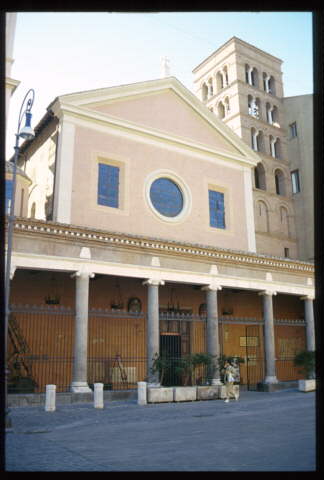
Beneath the
church is an archaeological area that allows us to reconstruct its
construction phases and historical events. Next to the sacristy, a
corridor, known as the Laurentina, leads to the underground
chambers, uncovered by excavation work. The concrete traces visible
directly above the central nave and its meridian section are primarily a
room paved with black and white mosaics featuring geometric designs,
typical of the 2nd century AD. The perimeter wall of the apse rests on a
rectilinear wall from an earlier period, frescoed with plant motifs and
divided into broad bands. Excavations revealed that directly beneath the
Basilica was an insula, somewhat comparable to our modern apartment
buildings, built in the early third century. It cuts across the previous
structures with a network of cruciform pillars, spanning the entire
central section of the church, from the original threshold of the
fifth-century church to the crypt area beneath the apse, encompassing both
the floor and the frescoed wall. It is precisely the threshold of the
primitive church that gives the impression of the sacred building being
superimposed on what would evidently have been a normal civil, residential,
and commercial building.
One of these
residences was owned by a certain Lucina, who had provided
hospitality to the early Christian communities for their meetings and
prayers. It was
there that the Conclave that elected Pope Damasus took place on
October 1, 366, with St. Jerome, a Church Father,
as his secretary. A few days earlier, on September 24, 366, a group of
priests, including the deacons Ursinus, Amantius, and Lupus, had gathered
in the Basilica of Pope Julius in Trastevere (S. Maria in Trastevere)
and proclaimed Ursinus Bishop of Rome. Ursinus's followers were
subsequently brought back into obedience to the legitimate Pontiff. Pope
Damasus was canonized, and the feast of Saint Damasus is December 11.
In the first half of the 5th century, the site was used or transformed into a
church. We find mention of the first basilica in the Liber Pontificalis,
regarding the life of Sixtus III, Pope from 432 to 440, where we read
that he also built a basilica dedicated to Saint Lawrence, with the
permission of Emperor Valentinian II. Very little information remains
about this basilica. Of this basilica, we can see: the three thresholds, resting
on the remains of the insula, over which the current façade is
superimposed, which retains only one of the three original doors; the structures
corresponding to the three original naves and the raising of the basilica's
floor in the 16th century; and the foundation wall of the central nave, made of
brick and tuff.
A very important find was also unearthed: a baptistery located on the same level as the first basilica, beneath the Hall of the Canons (now the Parish Museum). It consisted of a font with an adjoining basin, the function of which is unclear (baptism of infants or a water reservoir). It dates back to the 5th century AD and was demolished between 1441 and 1451 to build the Chapel of St. John the Baptist, now the Hall of the Canons.
Pope Benedict II, from 684-685, undertook restoration work and donated vestments to the Church of San Lorenzo "qui appellatur lucinae" (that is, "which is called Lucina"), indicating that this reputation was already well known. Over the centuries, numerous interventions on the building and donations from the popes followed. Historical documents also record two floods of the church, due to the overflowing of the Tiber in the mid-9th century. In the portico in front of the church, a plaque indicates the level reached by the flood.
In 1084, the church was sacked by the Normans led by Robert Guiscard, following which extensive renovations were carried out in the following century. In 1103, Antipope Anacletus II dedicated the church on May 25th and placed the relics of Alexander and other martyrs in the high altar. In 1112, Pope Paschal II placed numerous relics from the church: the gridiron, which came from an old altar in the church, was moved to the high altar; the relics of Saint Pontian and his companions, martyrs of Acquatraversa; and many others.
On the Papal throne, which is now hidden by a door in the choir behind the high altar, there is an inscription by Antipope Anacletus II, which states that Pope Paschal II had the gridiron removed from an old altar, along with two vials of blood, and that Bishop Leo of Ostia had everything replaced under this new altar, and this is the most important testimony to the medieval restructuring of the Church.
When it was handed over to the Order of the Clerics Regular Minor of San Francesco Caracciolo in 1606, the basilica underwent a transformation from an early Christian basilica into a Baroque one: the walls and roof of the central nave were raised; the side chapels were gradually built and were all completed by 1779. Shortly thereafter, around the mid-17th century, the interior was completely transformed by Cosimo Fanzago, who transformed the church into a single-nave hall and reduced the side aisles to family chapels (notable is the "Chapel of San Giuseppe," granted "in perpetuity" to the Ottoboni family, Dukes of Fiano, and destroyed in 1943 by Cardinal Carlo Cremonesi to make it his tomb). A further restoration in the 19th century eliminated the Baroque decorations, leaving only the pulpit intact.
In 1800, again due to persistent dampness, a further restoration was undertaken, during which the ceiling was completely redone and two new chapels were built on either side of the presbytery. After 1870, with the unification of Italy, the church passed to the Fund for Worship, and since 1906 it has been managed by the secular clergy of the diocese of Rome. Between 1918 and 1919, Cardinal Gasparri oversaw yet another restoration of all the surfaces, while in 1927 the Superintendency of Monuments restored the portico to its original appearance.
Given the persistent dampness problem, excavations and restorations of the basement were carried out by the Archaeological Superintendency of Rome between 1982 and 1987, resulting in "improved air circulation and a significant benefit for the entire building."
On July 18, 1910, there was the funeral of the father of Msgr. Domenico Tardini, who would become a cardinal in 1958 and Pope John XXIII's Secretary of State. Tardini recalled it in his diary: "The Church of San Lorenzo in Lucina was quite crowded: the vast majority were seminarians and friends of mine. The music was performed by the best singers in Rome: I had called them, I had planned the program. The funeral procession was performed by a number of Capuchins, and with some solemnity..."
On March 18, 1928, the episcopal consecration of Msgr. Pietro Ciriaci was celebrated in the basilica. He would become a cardinal in 1953 and titular Bishop of San Lorenzo in Lucina from 1964 until his death. Msgr. Ciriaci was consecrated bishop by Cardinal Pietro Gasparri, Vatican Secretary of State, with Msgr. Carlo Cremonesi and Msgr. Augustine Zampini.
The
entrance to the church today consists of a portico with six granite
columns with capitals and bases, surmounted by an architrave made from a
massive, reused ancient fluted column. The crowning element, with a
triangular pediment and moldings, is higher because it corresponds to the
raising of the walls of the central nave carried out in 1643. Various
inscriptions and reliefs discovered several times in the excavation area
between 1927 and 1928 have been placed in this entrance portico.
The bell tower, to the right of the façade, is in Romanesque style and
dates back to the 12th century and is attributed to Roman craftsmen.
There are three possible itineraries for visiting the church.
- Christological Itinerary, mainly following three
fundamental moments of Jesus' earthly life, represented by the Baptism
(first chapel on the left, that of the Baptistery), which marks the
beginning of His public life; the Crucifixion, a crucial moment,
represented mainly by the presence on the altar of the work by Guido
Reni (1575-1642), The Crucifix, painted between 1637 and 1640;
we also have the Chapel of the Crucifix (front chapel on the right),
which preserves an imposing wooden crucifix from the sixteenth century and
in which is placed the funerary monument in honor of Umberto II,
the last king of Italy, remembered as the "King of May"; the Ascension
of Christ, painted in the center of the coffered ceiling, where the
risen Christ is between Saints Lawrence, Damasus, and Lucina is by Francesco
Caracciolo, a work from 1857.
- Marian Itinerary. There are so many references to the Virgin Mary in this Basilica that it is impossible to describe them all. The vault features scenes from the life of Mary, attributed to Simon Vouet (1590-1649), depicting her Birth (an episode not described in the Canonical Gospels, but only in the Apocrypha), the Annunciation, the Presentation in the Temple, and the Assumption. There is an Annunciation by Ludovico Gimignani, a pupil of Reni, a copy painted in 1664 from the original by Guido Reni, preserved in the chapel of the same name on the Quirinale. The most prominent image is undoubtedly the one in the Chapel of the Immaculate Conception (the front right chapel), which dates back to the 19th century and is believed to have been painted on the occasion of the proclamation of the dogma of the Immaculate Conception by Pope Pius IX (1854). The artist was inspired by the vision described in Revelation 12,1: "A great sign appeared in heaven: a woman clothed with the sun, with the moon under her feet." In the fourth chapel on the right side, that of the Annunciation, there are sculptures made by Gian Lorenzo Bernini commissioned by Gabriele Fonseca, an illustrious doctor who at the time owned the chapel itself. A curious painting of the Virgin can be seen above the chapel of Saint Francis of Assisi and Saint Giacinta Marescotti, entitled Madonna delle Grazie, attributed to Girolamo Siciolante da Sermoneta (1521 1575), executed with a rather rare technique, oil on slate. On the Virgin's head shines a crown of stars, we notice the sweet and smiling face of Mary who has her arms raised and her three fingers spread, a curious iconography.
-
Laurentine Itinerary, that is, relating to San Lorenzo (Saint Lawrence the
Martyr), the titular Saint of the Church. Saint Lawrence was the first
of the seven deacons of Rome, who, according to tradition, was martyred
during the persecution of Emperor Valerian, who in 258 AD
had ordered the killing of Christian bishops, priests, and deacons, along
with the confiscation of their property. In this persecution Pope Sixtus
II was also beheaded. Saint Lawrence was martyred on
August 10, and Church Fathers such as Saint Augustine, Saint Ambrose, and
Saint Prudentius have recorded that he suffered torture on the gridiron.
Tradition holds that this instrument is present in the Basilica: the urn
containing the relic of the gridiron is visible under the altar of the Lovatti
Chapel, while the reliquary with the chains of Saint Lawrence is kept
in the Parish Museum.
The cult of Saint Lawrence the martyr spread immediately in Rome, so much
so that he was the first of the martyrs to have a cult within the city, in
the church of San Lorenzo in Damaso, built during the time of Pope Damasus
(366 –384). In the Middle Ages, there were more than 30 churches in Rome
dedicated to Saint Lawrence, and there are still eight today: in addition
to San Lorenzo in Lucina, San Lorenzo fuori le mura al
Verano, where he is buried, San Lorenzo in Damaso, where he
served as a deacon, San Lorenzo de' Speziali in Miranda,
where he was sentenced to death, San Lorenzo in Fonte, where
he was imprisoned, San Lorenzo in Panisperna, where he was martyred,
San Lorenzo in Palatio (near San Giovanni in Laterano, it
was the chapel of the Pontiffs in the Middle Ages, accessed from the Scala
Santa) and San Lorenzo in Piscibus (dismantled in 1936 and
then rebuilt for the construction of Via della Conciliazione; it
also housed the Martyrdom of Saint Lawrence by Giacinto Brandi,
which later disappeared). A ninth church, S. Lorenzo ai Monti,
dating back to the medieval period, was demolished in 1933 during the
construction of Via Fori Imperiali (it was located on the slopes of
the Campidoglio, on the Clivus Argentarium, near Via
Macel de' Corvi).
Saint Ambrose remembers Saint Lawrence as the martyr of charity,
because he sold all the Church's treasures and distributed the proceeds to
the poor, rather than have them confiscated by the Roman authorities. In
popular tradition, the shooting stars on August 10th, the saint's feast
day, are believed to be the sparks from the gridiron on which Saint
Lawrence was martyred.
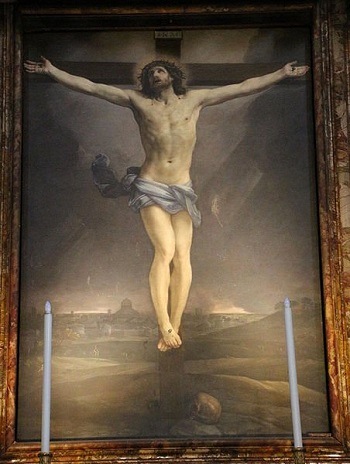
The Crucifixion by Guido Reni, altarpiece of the main altar
Description of the Basilica
The high
altar is the work of Carlo Rainaldi. Behind it is the famous
crucifix by Guido Reni, while the choir is decorated with the Virgin
and Saints by Placido Costanzi (1702-1759). The altarpiece by Guido
Reni (1575-1642) was painted in Bologna between 1637 and 1638 and
donated by the Marchioness Cristina Duglioli Angelelli, who
had brought the painting to Rome in 1644. The Marchioness, who died on 8
January 1669, had explicitly provided for the donation of the painting to
the basilica in her will the previous year, in which she also expressed
her wish to be buried in the same church of San Lorenzo in Lucina.
The coffered ceiling of the nave has a
painting at its centre depicting the Ascension of Jesus with Saint
Lawrence, Saint Damasus, Saint Lucina and Saint Francis Caracciolo by Roberto
Bompiani (1821-1908). On the walls, the cycle of paintings with
episodes from the life of Saint Lawrence dates back to 1860 and is also
the work of Bompiani.
The chapels on the right side of the church
1) The first chapel from the entrance is dedicated to San Lorenzo and has been owned by the Lovatti family since the mid-19th century (see the description in the relevant paragraph below).
2) The second chapel, designed by Carlo Rainaldi, is dedicated to Saint Anthony and contains paintings by the Flemish painter Jan Miel (1599-1663) on the life of the Saint to the right and left of the altar.
Between the second and third chapels is the monument to Nicolas Poussin, created between 1829 and 1830 by Paul Lemoyne and Louis Desprez at the request of the writer Francoise René de Chateaubriand.
3) The third chapel is dedicated to Saint Francesco Caracciolo (1563-1608), founder of the Order of Minor Clerics Regular, to whom the basilica was entrusted from 1606 to 1873. The altarpiece, Saint Francis Caracciolo Adoring the Blessed Sacrament, was painted in 1752 by Ludovico Stern (1709-1777).
4)
The fourth chapel, dedicated to the Annunciation, known as the Fonseca
Chapel after the family who commissioned it, was designed by Gian
Lorenzo Bernini (1598-1680), who also sculpted, between 1668 and 1674,
the bust of the Marquis Gabriele Fonseca, who was also the
physician to Pope Innocent X. The altarpiece is the Annunciation
by Ludovico Gimignani (1643-1697), a copy of the fresco by Guido
Reni created in 1610 in the Quirinale Palace. The bust of Isabella
Cardoso Gomez, wife of Gabriele Fonseca (1586-1668), was
commissioned by her daughter Antonia Fonseca Arboli from the sculptor Giulio
Cartari (1642-1699), a disciple and faithful collaborator of Gian
Lorenzo Bernini. On the dome of the chapel the stucco angels were created
between 1662 and 1670 by the Bernini School.
The chapels on the left side of the church
1) The first is the baptistery, a work from around 1715 by the architect Giuseppe Sardi (1688-1770). The central painting of the baptistery, depicting the Baptism of Christ, is by Giuseppe Nasini (1657-1736).
2) The second chapel, dedicated to Saint Carlo Borromeo. The altarpiece Saint Charles carrying the nail from the cross in procession (1618) is by Carlo Saraceni (1585-1625), a distinguished and greatest disciple of Caravaggio (he is the author of the famous Transit of the Virgin of 1610, in the church of Santa Maria della Scala in Trastevere, which replaced The Death of the Virgin by Caravaggio, rejected by the Carmelites, now in the Louvre in Paris). The paintings on the side walls (on the right Saint Charles giving communion to the plague-stricken and on the left Saint Charles distributing alms to the poor) are by Gregorio Preti (1603-1672).
3) The third chapel is dedicated to Saint Giovanni of Nepomuk, a priest of Prague Cathedral, who was drowned in 1393 (for his refusal to reveal what he had told the Queen in confession) by the King of Bohemia, Wenceslaus of Luxembourg (1361-1419). Saint Giovanni was proclaimed a saint by Pope Benedict XIII in 1729. On the high altar is a marble statue of the Saint, a work by Gaetano Altobelli from 1737. On the left wall is Saint John as a prisoner before the King of Bohemia, and on the right wall is Saint John led to martyrdom on the Vltava River, near Charles Bridge.
Between the third and fourth chapels is the marble pulpit made in 1649-50 by Cosimo Fanzago (1591-1678).
4) The fourth chapel is dedicated to Saint Joseph. The altarpiece is by Alessandro Turchi (1578-1649) and depicts the Holy Family, while on the left wall is the tomb with the marble bust of Cardinal Carlo Cremonesi (1866-1943), titular of the basilica from December 19, 1935, until his death. This chapel was the private chapel of the Ottoboni princes, Dukes of Fiano (Pope Alexander VIII's family), who received it, by papal brief, in "perpetual concession" (their coat of arms is still visible above the entrance). In 1943, the chapel was altered from its original purpose to become the tomb of Cardinal Cremonesi and was clad in green marble, which covered the tombstones of the deceased Ottoboni family.
5) The fifth chapel is dedicated to Saint Francis of Assisi and Saint Giacinta Marescotti (1585-1640). The altarpiece, the Death of Saint Giacinta Marescotti (1736) is by Marco Benefial (1684-1764); on the left wall The Temptation of Saint Francis, and on the right The Dressing of Saint Francis, both by Simon Vouet (1590-1649) painted around 1636, like the frescoes on the vault (Saint Peter, Saint Paul, Saint Mary Magdalene, Saint Clare of Assisi, Saint Lucy). Above, on the cymatium, the Madonna in Glory by Bernardino Luini (1480-1532). Vouet's two paintings dedicated to Saint Francis had a profound influence on Roman painting of the seventeenth and early eighteenth centuries; For over a century these two paintings, together with Reni's Crucifixion, constituted the basilica's major artistic attraction.
Marco
Benefial, Death
of Saint Giacinta Marescotti (1736)
The front chapels
The left chapel is dedicated to the Immaculate Heart of Mary, also called the Chapel of the Immaculate Conception, the right one is called the Chapel of the Crucifix.
Lovatti Chapel
The first chapel on the right was granted to the Lovatti family under the pontificate of Pius IX in the mid-19th century. In the 17th century, it had been placed under the protection of the Monatana family. The chapel's original 17th-century decoration, by Tommaso Salini (1575-1625), Giovanni Baglione (1573-1643), and Giovanni Battista Speranza (1600-1640), unfortunately has not survived. The chapel contains the tombs of Clemente (1777-1859), Matteo (1770-1849), and Edmondo (1845-1855) Lovatti, as well as that of Cardinal Pietro Ciriaci. The altarpiece in the Lovatti chapel, painted in 1716 by Sigismondo Rosa (a pupil of Carlo Maratta and Tommaso Chiari), depicts Lucina presenting the church plan to San Lorenzo. Under the altar table is an 18th-century urn containing the remains of the gridiron on which, according to tradition, Lorenzo was martyred. On the left wall of the chapel, a 19th-century painting by Giuseppe Creti depicts Saint Lawrence presenting the poor to Dacianus, Prefect of Rome in 258, explicitly referencing the tradition according to which Dacianus granted Lorenzo three days: if he handed over the treasures of the Roman church, his life would be spared. On August 10, Lorenzo presented himself to the Prefect, followed by a procession of poor people, and said: "Behold, these are our treasures: they are eternal treasures; they never fail, indeed, they increase." On the right wall, the martyrdom of Saint Lawrence is depicted in a painting, also by Giuseppe Creti.
The commission to create Matteo Lovatti's funerary monument was given to the sculptor Giuseppe Guidi (probably a relative of his wife), who created a neo-Renaissance style monument with a crown of acanthus scrolls, with the bust of the deceased in the center and a laurel wreath with symbols of the arts and letters at the bottom.
Pietro
Ciriaci (1885-1966), titular cardinal priest of the church
from 1964 to 1966, became cardinal in 1953. He graduated in philosophy,
theology, and law, was ordained a priest in 1909, and a bishop in 1928. He
taught philosophy at the College of Propaganda Fide and at Sant'Apollinare,
and later served as nuncio to Czechoslovakia and Portugal. On March 20,
1954, he was appointed Prefect of the Sacred Congregation of the Council.
He participated in the conclaves of 1958 and 1963 and in the Second
Vatican Council, during which he was president of the Commission on Clergy
discipline and drafter of the conciliar decree Presbyterorum Ordinis.
Before the Council, on June 5, 1960, he was appointed by Pope John
XXIII as president of the Preparatory Commission for the Discipline of
the Clergy and the Christian People, which had jurisdiction over the
distribution of the clergy, the question of the irremovability of parish
priests, the sanctity of priestly life, ecclesiastical precepts, the
instruction of the faithful and catechism, ecclesiastical benefices, the
historical and artistic heritage of churches, confraternities, social
security for the clergy, donations, and the ordination of converted
ministers. Monsignor Domenico Tardini recalls him in his diary when
he was nuncio in Lisbon. On September 13, 1934, he wrote: "An
inexhaustible and brilliant reasoner, he builds a whole phantasmagoria of
castles, which are harmonious, attractive, plausible... but they are
castles in the air. Ciriaci does not realize this: he steadfastly pursues
the practical application of what his reasoning has so brilliantly
suggested to him, and thus makes the wrong assessments, reverses
situations, discovers nonexistent friendships or enmities, worries,
anguishes, and becomes agitated. And since his temperament and the
terrible nostalgia from which he suffers, however much he tries to hide it,
lead him toward pessimism, he is never calm, never at peace, but always on
a war footing, always restless, always anxious, like someone who sees
plots and snares almost everywhere. So put together intelligence, vivacity,
stubbornness, nostalgia, pessimism, restlessness, and you get a Ciriaci
who must undoubtedly lack balance in the reality of life. [...] Ciriaci,
as always, was cordial, warm, and effusive towards me."
Cardinal Ciriaci is also credited with a famous quip, uttered during the
1958 Conclave (which elected John XXIII) to criticize the candidacy of
Cardinal Giuseppe Siri (1906-1989), who was only 52 years old at
the time, and who, if elected, would have become "not a Holy
Father, but an... eternal Father".
Giuseppe Creti, Saint Lawrence presents the poor to Dacianus
Giuseppe Creti, Martyrdom of Saint Lawrence
Sigismondo Rosa, Lucina shows Saint Lawrence the plan of the church
Urn containing the remains of the gridiron, under the altar table of the Lovatti Chapel
People buried in the basilica:
Inside
the basilica are several very interesting funerary monuments from various
periods, including, on the pillar between the second and third chapels on
the right, the monument to Nicolas Poussin (1594–1665). It is
unknown why the French painter was buried in this church. Another
interesting fact is that a tombstone was erected over his tomb between
1823 and 1830, commissioned by René de Chateaubriand (1768–1848),
a French writer, when he was French minister in Rome. The
marble structure is by the architect Louis Vaudoyer and consists of
a sort of very simple white ‘edicule’, in which the central
bust of Poussin is within a small arch and rests on a base, beneath which
a marble slab of a different colour (ivory) has been inserted with a
dedication from Chateaubriand to Poussin and a relief reproducing the
painter's 1640 painting, Les bergers d'Arcadie, (The Shepherds of
Arcadia).
The
inscription “ET IN ARCADIA EGO” is clearly legible. The relief
reproduces, as has been said, a painting by Poussin, an artist active in
Rome from 1624 to 1640 and from 1642 until 1665 (the date of his death).
It depicts three shepherds and a shepherdess intent on reading the
inscription on an ancient tomb, which says, precisely, “Et in Arcadia
ego” against the backdrop of a dark mountain. Poussin’s painting,
created between 1637 and 1639, is now preserved in the Louvre Museum in
Paris. In the 1970s, a curious coincidence was discovered: the tomb,
identical in size and shape and even in its landscape setting, actually
exists in the French village of Arques, in the Aude Department. One
of the hills that can be seen in the distance is that of Rennes le
Chateau, linked to the well-known mysteries involving Abbot
Sauniere.
Poussin was certainly influenced by a
painting by Giovan Francesco Barbieri, known as Guercino,
who painted a similar scene between 1618 and 1622; today the painting is
housed in the gallery of Palazzo Barberini in Rome. It seems that Nicola Poussin was a member of
the Accademia Arcadia, a sort of esoteric circle, so what did he and
Guercino want to tell us with these paintings? And why did the writer Renè
de Chateaubriand feel - two centuries after Poussin's death - the need
to place a dedicatory plaque choosing that very theme among the many
paintings the artist created? "Trattieni
le pie lacrime, vive in (questa) tomba Poussin che
sembrava non dovesse morir mai. Eppure
egli ora tace; ma se vuoi sentirlo parlare nei
suoi quadri egli è vivo e (da essi) parla" We
know that Chateaubriand served at the court of Napoleon, a notoriously
pro-Masonic figure who came to Rome first as a diplomat in the service of
Cardinal Fesch, Napoleon's ambassador to Rome, and then himself as
ambassador of Restoration France. He frequented the pontiffs Pius VII,
Pius VIII, and Leo XII; among artists, he celebrated the memory of
Poussin and admired the masterpieces of Canova, as well as meeting two
then-novice painters, Ingres and Corot. This connection
between Poussin and Chateaubriand may simply be an act of admiration for
the seventeenth-century painter, whom René would have liked to
commemorate by placing a dedicatory plaque on his tomb, but further
research may reveal new and interesting elements.
the French painter Nicolas Pussin (1594-1665)
in a tomb built in the 19th century by Chateaubriand, then
ambassador to Rome
the Flemish painter Frans van de Casteele, better known in
Rome as Francesco di Castello (1540 around-1621),
the German painter and astronomer Adam Elsheimer (1578-1610),
the Roman Caravaggesque painter Orazio Borgianni (1574-1616),
the Roman Baroque painter Tommaso Salini (1575 around-1625),
the painter Pompeo Batoni (1708-1787) the most famous Italian
painter of the eighteenth century after Giambattista Tiepolo,
the painter Ludovico Stern (1709-1777), Roman painter who painted San
Francesco Caracciolo adoring the Blessed Sacrament for the basilica,
the painter Veronica Stern (1717-1805) miniaturist, daughter of
Ignaz Stern,
the Roman painter Vincenzo Camuccini (1771-1844),
the landscape painter Guglielmo Federico Gmelin di Karlsruhe (1764-1820),
Advisor to the Grand Duke of Baden and Academician of San Luca,
the Brescian composer Luca Marenzio (1553-1599) among the most
appreciated authors of madrigals of the 16th century,
the Czech composer Josef Myslivecek (1737-1781), a friend of Mozart,
known as "the divine Bohemian",
the Tuscan composer and organist Bernardo Pasquini (1637-1710) who
in Arcadia had the name of Protico Azoteo,
the Catalan composer Domingo Miguel Bernabè Terradellas
(1713-1751),
the baroque sculptor Lazzaro Morelli (1608-1690),
the architect Raffaele Stern (1774-1820), who reintegrated the lost
parts of the Arch of Titus and the Colosseum,
the architect Matteo Lovatti (1770-1849),
the marquis Clemente Lovatti (1777-1859), Matteo's brother,
the marquis Gabriele Fonseca (XVII century),
the marquis Giuseppe Zagnoni (died in 1803),
the marquise Cristina Duglioli Angelelli (died
in 1669), donor of the altarpiece by Guido Reni
at the main altar,
the archaeologist Carlo Fea (1753-1836), art collector and
architectural historian,
Dr. Giuseppe De Matthaeis (1777-1857), papal physician, surgeon and
archaeologist,
Albert Auguste Androt (1781-1804) director of the French
Conservatory in Rome and of the School of Fine Arts,
Basilio Paolo Lisakewitz (1791-1817), knight of the Tsar of Russia,
Maria Francesca Ottoboni (1716-1758), wife of Pietro Gregorio
Boncompagni Ludovisi, Duke of Fiano,
Alessandro Ruspoli (1708-1779) Prince of
Cerveteri,
Carolina Ruspoli (1805-1881) Princess,
Prince Eugenio Ruspoli (1866-1893) explorer,
the English cardnal Ugo di Evesham, died in 1287, titular cardinal
of the church from 1281,
the French cardinal Jean le Jeune (1411-1451), former bishop of
Macon, Amiens and Therouanne, titular cardinal of the church since 1441, died in
Rome from poisoning on 9 September 1451,
the cardinal Filippo Calandrini (1403-1476), titular cardinal of
the church from 1451 to 1468,
the cardinal Silvio Passerini (1469-1529), titular cardinal of the
church from 1520,
the cardinal
Francesco Gonzaga said the Young (1538-1566),
titular cardinal of the church from 1562,
the cardinal
Luigi Capponi (1583-1659), titular
cardinal of the church from 1629,
the cardinal
Galeazzo Mariscotti (1627-1726), titular
cardinal of the church from 1708,
the cardinal
Giuseppe Renato Imperiali (1651-1737), titular
cardinal of the church from 1727,
the cardinal
Gianantonio De Via ( o Davia, 1660-1740), titular
cardinal of the church from 1737,
the cardinal
Giacomo Filippo Fransoni (1775-1856)
titular cardinal of the church from 1855,
the cardinal
Gabriele della Genga Sermattei (1801-1861),
Archbishop of Ferrara from 1834 to 1843, titular
cardinal of the church of San
Girolamo dei Croati from 1836,
the cardinal
Carlo Cremonesi (1866-1943), titular
cardinal of the church from 1935,
the cardinal
Pietro Ciriaci (1885-1966),
titular cardinal of the church from 1964.
The
tomb of Nicolas Poussin and the “Shepherds of Arcadia”
Memories of early bereavements
(The information on San Lorenzo was taken from various websites and from Maria Elena Bertoldi's booklet, and summarized. Except for the information on the Lovatti Chapel, it is not based on specific research)
Fiano Palace
Fiano Palace (San Lorenzo in Lucina Square, n. 2-5, corner of Via del Corso, n. 405-418) was the residence of the cardinals who held the titular office of the basilica from the end of the 13th century to 1624
Fiano
Palace takes its name from Marco Ottoboni (Venice 1656 - Rome
1725), nephew of Pope Alexander VIII, who was appointed Duke of
Fiano Romano by the Pope on April 18, 1690. The duke purchased the
palace from the Ludovisi Family.
The original nucleus of the palace was built in the 13th century by the
English Cardinal Ugone Atratus of Evesham (titular cardinal of the
basilica from 1281, died 1287) on the ruins of the so-called Palace of
Domitian. The palace thus became the residence of the titular
cardinals of the Basilica of San Lorenzo. In the 1420s, the palace was
expanded and renovated by Cardinal Jean de la Roche Taislée, known
as Rotomagense, served in San Lorenzo in Lucina from 1426 to 1437.
Between 1441 and 1451, the palace was significantly restored and enriched
with works of art by Cardinal Jean Le Jeune de Contay, known as Morinense.
From 1488 to 1508, the Portuguese Cardinal Giorgio de Costa lived
there. The last titular cardinal of the basilica to live in the palace was
Alessandro Damasceni Peretti di Montalto, nephew of Pope Sixtus IV,
from 1621 to 1624.
In 1624, by order of Pope Urban VIII, the palace was sold for 36,000 scudi to Michele Peretti, Prince of Venafro (1577-1631), brother of Cardinal Alessandro. The Peretti Family carried out several renovations and partial expansions of the palace, including the reconstruction of the wing on Via Lucina and its façade. During these works, various artifacts dating back to the Augustan era were discovered (one is currently in the Louvre, another in the Vatican Museums); only in 1879 did the German archaeologist Friedrich von Duhn (1851-1939) establish that they belonged to the famous Ara Pacis built by the Emperor Octavian Augustus. Between 1903 and 1905, further excavations were carried out, allowing the recovery of other parts of the Ara Pacis.
Abbot Paolo Savelli Peretti sold the building to Costanza Ludovisi Pamphilj, wife of Nicolò Ludovisi, Prince of Piombino, in the second half of the seventeenth century.
On April 4, 1723, Duke Marco Ottoboni purchased the Chapel of San Giuseppe in the adjacent Basilica of San Lorenzo in Lucina for himself and his descendants. In 1731, Maria Francesca Ottoboni (1715-1758), the Duke's eldest daughter, married Prince Pietro Gregorio Boncompagni Ludovisi (1709-1747), who obtained the Ottoboni name, coat of arms, and titles by papal trustee, including the title of Duke of Fiano, which was transferable to his heirs. The palace's current facades were designed in 1888 by architect Francesco Settimj on behalf of Duke Marco Boncompagni Ludovisi Ottoboni. In 1898, the palace was sold to Edoardo Almagià. In the 19th century, the palace housed the Fiano Theater, with entrance at Via del Corso 418, which hosted puppet shows. The theatre is also mentioned by Stendhal (Marie-Henri Beyle) who entered it in 1817 to attend a puppet show (Stendhal, Rome Naples Florence, Italian tr., Melita, La Spezia 1982).
Connected to Palazzo Fiano until 1662 was the so-called Arch of Portugal (built during the reign of Emperor Aurelian), which cut across Via del Corso at right angles, significantly narrowing its carriageway. It was demolished by order of Pope Alexander VII, as it was not only in precarious condition but also considered an obstacle to traffic. The arch was named after the Portuguese Cardinal Giorgio de Costa, titular bishop of the Basilica of San Lorenzo in Lucina, who, as we have seen, lived in the palace from 1488 to 1508.
The Basilica of San Lorenzo in Lucina - Wikipedia
La Basilica di San Lorenzo in lucina e la cappella Lovatti (in Italian)
tombs of Lovatti Family in San Lorenzo in Lucina (in Italian)
